Mechanisms of Surrounding Rock Failure and Control Measures When Main Roof Fractures Directly Above Gob-Side Entry in Thick Coal Seam
Abstract
1. Introduction
2. Engineering Background Profile
3. Mechanical Model of Overburden Rock Structure
3.1. Key Triangular Block Structure of Gob-Side Entry
3.2. Top Coal Subsidence Model and Numerical Simulation
3.2.1. Top Coal Subsidence Model
3.2.2. Numerical Simulation
- (1)
- The numerical results demonstrate that the roadway roof experiences tensile stresses of approximately 2 MPa under both operational conditions, significantly exceeding the tensile strength 0.5 MPa for coal seams. This substantial stress–strength imbalance indicates a high risk of roof failure.
- (2)
- The compressive stress value at the junction of the coal seam and the immediate roof fluctuates in the range of 2 to 5 MPa. Notably, shear failure has already taken place within the coal mass at this location and the shear position is located directly below the fracture line.
- (3)
- When the MRFL is arranged at 1.5 m from the side of the coal pillar, the solid coal side of the roadway is closer to the vertical stress peak area. In contrast, when the distance is 2.5 m, the vertical stress peak covers a wider range on the solid coal side. The vertical stress peak of the former is 19.5 MPa, and the vertical stress peak of the latter is 21.6 MPa.
4. Similarity Simulation Experiments
4.1. Similarity Simulation Material Ratio
4.2. Simulation Experiment Process
5. Control of Fracture of Main Roof Directly Above Roadway
5.1. The Important Role of Anchor (Cable) Prestress
5.2. Five-Hole Tray and Prestressed Field of High-Strength Prestressed Anchor Cable
5.2.1. Five-Hole Tray and High-Strength Anchor Cable Support System
5.2.2. Prestress Field Analysis of Five-Hole Tray and High-Strength Anchor Cable
- (1)
- As the roof moved deeper away from the tail of the anchor cable, the compressive stress gradually diminished. A tensile stress zone emerged at the anchor cable’s end, albeit with a relatively modest stress value.
- (2)
- As the deflection angle of the anchor cables on both sides increased from 5° to 10°, the area of the effective compressive stress zone expanded significantly, forming a contiguous and overlapping effective compressive stress zone that nearly covered the entire roof area. Under both conditions, the coverage range of 0.01 MPa stress was significantly larger than that of 0.02 MPa. When comparing different angles, the stress coverage range at a deflection angle of 10° was markedly greater than that at 5°.
- (3)
- Grouting pipes were arranged through concealed chase for grouting reinforcement, with the diffusion range essentially covering the entire upper part of the anchored cable bundle.
6. Engineering Application Analysis
6.1. Roadway Roof Support
6.2. Support for Coal Pillar Sidewall
6.3. Support for Solid Coal Sidewall
6.4. Observation Results of Mine Pressure
7. Conclusions
- (1)
- Three structural models of the overlying rock were proposed when the MRFL is located above the gob-side entry. These models were classified as articulated, misaligned, and detached. Furthermore, a mechanical model was developed to simulate the shear subsidence of the top coal. By integrating this model with UDEC numerical simulations, we elucidated the mechanism of shear failure in the top coal when the MRFL is positioned above the roadway. The numerical results demonstrate that the roadway roof experienced tensile stresses of approximately 2 MPa, significantly exceeding the tensile strength 0.5 MPa for coal seams. The failure characteristics of the surrounding rock in the roadway obtained through similarity simulation experiments were generally consistent with those in the numerical simulation.
- (2)
- The prestress field of a five-hole tray combined with high-strength prestressed anchor cables was obtained by FLAC3D numerical simulation. It could be clearly seen that a continuous overlapping effective compressive stress zone covering the entire roof was formed between the anchor cables, which gave full play to the active support of the anchor cables. The coverage range of 0.01 MPa stress was significantly larger than that of 0.02 MPa. When comparing different angles, the stress coverage range at a deflection angle of 10° was markedly greater than that at 5°.
- (3)
- After adopting the five-hole tray support system integrated with high-strength prestressed anchor cables, the deformations of the roof and both coal walls were effectively controlled within a limited range. The monitoring data indicated that the deformation stabilized approximately 30 days post-excavation, with a maximum roof subsidence of 159 mm. Additionally, maximum convergence values of 219 mm and 160 mm were recorded on the pillar side and solid coal side, respectively. These findings provide robust theoretical and technical support for roadway stabilization under similar geoengineering contexts.
Author Contributions
Funding
Institutional Review Board Statement
Informed Consent Statement
Data Availability Statement
Acknowledgments
Conflicts of Interest
Abbreviations
| MRFL | Main roof fracture line |
| KTBB | Key triangular block B |
References
- Xu, S.S.; Peng, S.P.; Cheng, A. Coal Scientific Production Capacity and Resource Guarantee Level Analyses in China. Coal Geol. China 2011, 23, 1–4. [Google Scholar]
- Wang, J.C.; Zhong, S. The present status and the key issues to be resolved of thick seam mining technique in China. Sci. Online 2008, 11, 829–834. [Google Scholar]
- Hu, S.R.; Lin, L.N.; Huang, C.; Chen, D.Y.; Hao, G.Q. Distribution and Genetic Model of Extra-thick Coal Seams. Coal Geol. China 2011, 23, 1–5. [Google Scholar]
- Wang, G.F.; Pang, Y.H. Fully mechanized coal mining and caving mining method evaluation and key technology for thick coal seam. J. China Coal Soc. 2018, 43, 33–42. [Google Scholar]
- Song, X.; Zhu, D.; Wang, Z.; Huo, Y.; Liu, Y.; Liu, G.; Cao, J.; Li, H. Advances on Longwall Fully-mechanized Top-coal Caving Mining technology in China During Past 40 years: Theory, equipment and approach. Coal Sci. Technol. 2021, 49, 1–29. [Google Scholar]
- Wang, J.; Yu, B.; Kang, H.; Wang, G.; Mao, D.; Liang, Y.; Jiang, P. Key technology for fully-mechanized top coal caving with large mining height in extra-thick coal seam. J. China Coal Soc. 2013, 38, 2089–2098. [Google Scholar]
- Chen, D.; Zhu, J.; Ye, Q.; Ma, X.; Xie, S.; Guo, W.; Li, Z.; Wang, Z.; Feng, S.; Yan, X. Application of Gob-Side Entry Driving in Fully Mechanized Caving Mining: A Review of Theory and Technology. Energies 2023, 16, 2691. [Google Scholar] [CrossRef]
- Qian, M.G.; Miao, X.; He, F. Key block analysis of ‘masonry beam’ structure in stope. J. China Coal Soc. 1994, 19, 557–563. [Google Scholar]
- Hou, C.J.; Li, X.H. Stability principle of large and small structure of surrounding rock in gob-side entry driving with fully-mechanized caving. J. China Coal Soc. 2001, 26, 1–7. [Google Scholar]
- Zha, W.-H.; Li, X.; Hua, X.-Z.; Wu, T.-F.; Yin, S.-Y. Impact and application on narrow coal pillar for roadway protecting from fracture position of upper roof. J. China Coal Soc. 2014, 39, 332–338. [Google Scholar]
- Liu, J.; Li, C.; Shi, Y.; Zhang, Y. Stability Analysis and Fracture Patterns of Hard Main Roof in Longwall Top Coal Caving with Large Mining Height. Shock. Vib. 2021, 2021, 9930221. [Google Scholar] [CrossRef]
- Li, H.-B.; Li, D.-Y.; Wang, H.; Li, Z.-F.; Wang, S.; Chen, C.-L. Research on Stress Evolution Law and Failure Characteristics of Top Coal in Fully Mechanized Caving of Extra-Thick Coal Seams. Therm. Sci. 2014, 27, 687–695. [Google Scholar] [CrossRef]
- Yue, S.; Xie, S.; Chen, D.; Gao, M. Study on Surrounding Rock Control of Narrow Coal Pillar in Fully Mechanized Caving High Intensity Mining of 15 m Extra Thick Coal Seam. J. Min. Saf. Eng. 2017, 34, 905–913. [Google Scholar]
- Sun, X.; Zhao, W.; Wang, J.; Jiang, M.; Shen, F.; Zhang, Y.; Miao, C. Research on Failure Mechanism and Stability Control Technology of Dynamic Pressure Roadway in Ultra-Thick Coal Seams Under a High Depth of Cover. Min. Metall. Explor. 2023, 45, 1955–1972. [Google Scholar] [CrossRef]
- Wang, H.S.; Zhang, D.S.; Li, S.G.; Wang, L.; Wu, L. Determination of reasonable width of narrow coal pillar based on the location of B fracture line of key rock block of main roof. J. Min. Saf. Eng. 2014, 31, 10–16. [Google Scholar]
- Zhao, Y.M.; Zhang, N.; Wang, J. Failure properties of roadway with extra-thick coal seams and its control techniques. Heliyon 2024, 10, e23990. [Google Scholar] [CrossRef]
- Zhao, Y.; Yang, Y.; Li, X.; Wang, Z. Overlying Strata Movement and Abutment Pressure Evolution Process of Fully Mechanized Top Coal Caving Mining in Extra Thick Coal Seam. Geofluids 2021, 2021, 7839888. [Google Scholar] [CrossRef]
- Shan, R.; Liu, S.; Wang, H.; Li, Z.; Huang, P.; Dou, H. Research on the deformation mechanism and ACC control technology of gob-side roadway in an extra-thick coal seam with varying thickness. Energy Sci. Eng. 2024, 12, 1913–1933. [Google Scholar] [CrossRef]
- Chen, D.; Li, Z.; Xie, S.; Wang, Z.; Jiang, Z.; Jia, Q.; Wang, Y. The J2 evolution model and control technology of the main roadway surrounding rock under superimposed influence of double-coal seam mining. Sci. Rep. 2023, 13, 17569. [Google Scholar] [CrossRef]
- Chen, D.; Wang, Z.; Yue, S.; Xie, S.; He, F.; Tian, C.; Jiang, Z.; Liang, D.; Qi, B. Study on Surrounding Rock Control of Withdrawal Space in Fully Mechanized Caving Mining of a 19 m Extra-Thick Coal Seam. Appl. Sci. 2024, 14, 9694. [Google Scholar] [CrossRef]
- Cao, Z.Z.; Zhou, Y.J. Research on Coal Pillar Width in Roadway Driving Along Goaf Based on The Stability of Key Block. Comput. Mater. Contin. 2015, 48, 77–90. [Google Scholar]
- Wang, H.-S.; Shuang, H.-Q.; Li, L.; Xiao, S.-S. The Stability Factors’ Sensitivity Analysis of Key Rock B and Its Engineering Application of Gob-Side Entry Driving in Fully-Mechanized Caving Faces. Adv. Civ. Eng. 2021, 2021, 9963450. [Google Scholar] [CrossRef]
- Wen, J.; Zuo, J.; Wang, Z.; Wen, Z.; Wang, J. Failure mechanism analysis and support strength determination of deep coal mine roadways—A case study. Constr. Build. Materials 2024, 443, 137704. [Google Scholar] [CrossRef]
- Qi, F.; Zhou, Y.; Li, J.; Wang, E.; Cao, Z.; Li, N. Top-coal deformation control of gob-side entry with narrow pillars and its application for fully mechanized mining face. Int. J. Min. Sci. Technol. 2016, 26, 417–422. [Google Scholar] [CrossRef]
- Li, L.; Zhang, X.; Luo, J.; Hu, B. Theoretical Analysis of the Movement Law of Top Coal and Overburden in a Fully Mechanized Top-Coal Caving Face with a Large Mining Height. Processes 2022, 10, 2596. [Google Scholar] [CrossRef]
- Wang, D.; Zheng, Y.; He, F.; Song, J.; Zhang, J.; Wu, Y.; Jia, P.; Wang, X.; Liu, B.; Wang, F.; et al. Mechanism and Control of Asymmetric Floor Heave in the Gob-Side Coal Roadway under Mining Pressure in Extra-Thick Coal Seams. Energies 2023, 16, 4948. [Google Scholar] [CrossRef]
- Demin, V.; Khalikova, E.; Rabatuly, M.; Amanzholov, Z.; Zhumabekova, A.; Syzdykbaeva, D.; Bakhmagambetova, G.; Yelzhanov, Y. Research into mine working fastening technology in the zones of increased rock pressure behind the longwall face to ensure safe mining operations. Min. Miner. Depos. 2023, 18, 27–36. [Google Scholar] [CrossRef]
- Rakesh, K.; Kumar, S.A.; Kumar, M.A.; Rajendra, S. Underground mining of thick coal seams. Int. J. Min. Sci. Technol. 2015, 25, 885–896. [Google Scholar]
- Nguyen, L.Q.; Thi Le, T.T.; Nguyen, T.G.; Tran, D.T. Prediction of underground mining-induced subsidence: Artificial neural network based approach. Min. Miner. Depos. 2023, 17, 45–52. [Google Scholar] [CrossRef]
- Sun, J.Y.; Luo, X. Numerical simulation analysis of different coal mine roadway support effect. Int. Conf. Adv. Energy Environ. Sci. 2013, 807–809, 2356–2360. [Google Scholar] [CrossRef]
- Wang, J.; Liu, P.; He, M.; Tian, H.; Gong, W. Mechanical Behaviour of a Deep Soft Rock Large Deformation Roadway Supported by NPR Bolts: A Case Study. Rock Mech. Rock Eng. 2023, 56, 8851–8867. [Google Scholar] [CrossRef]
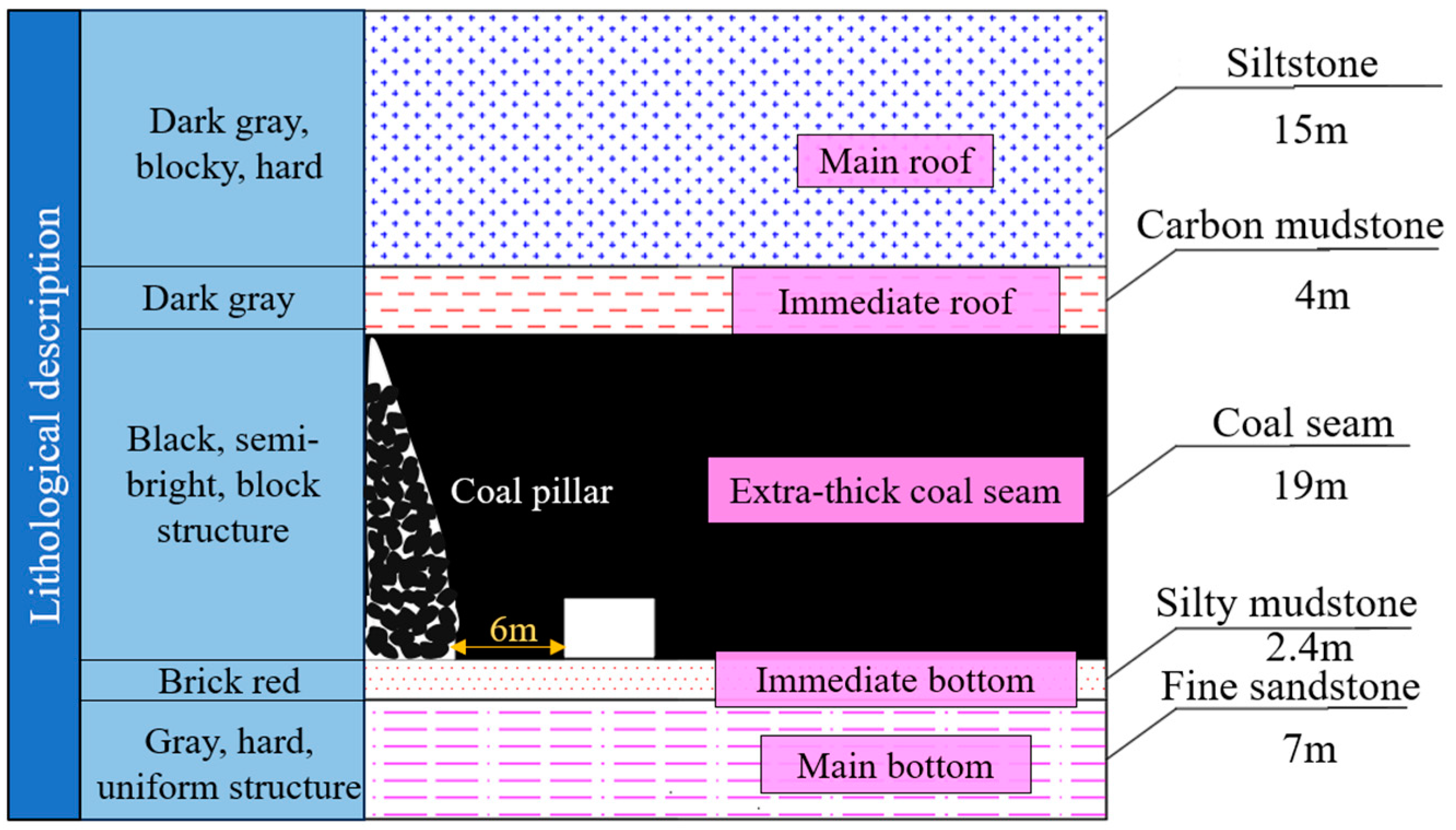

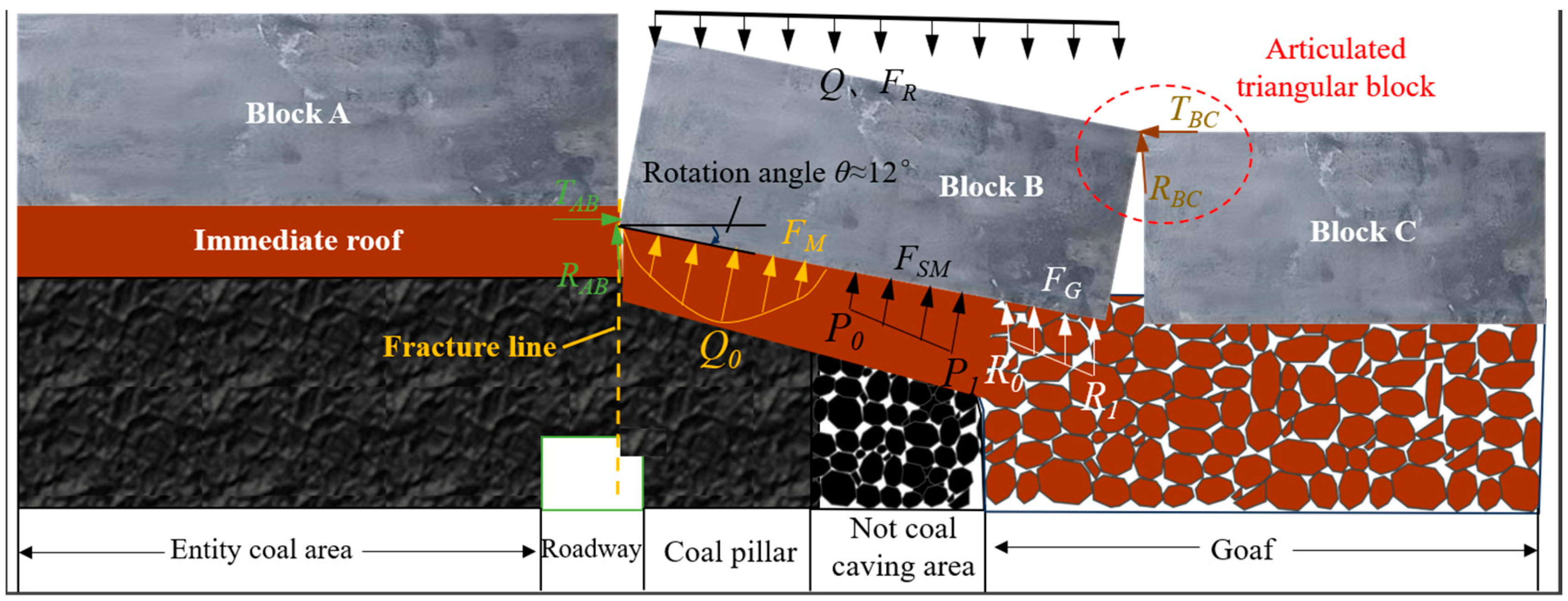
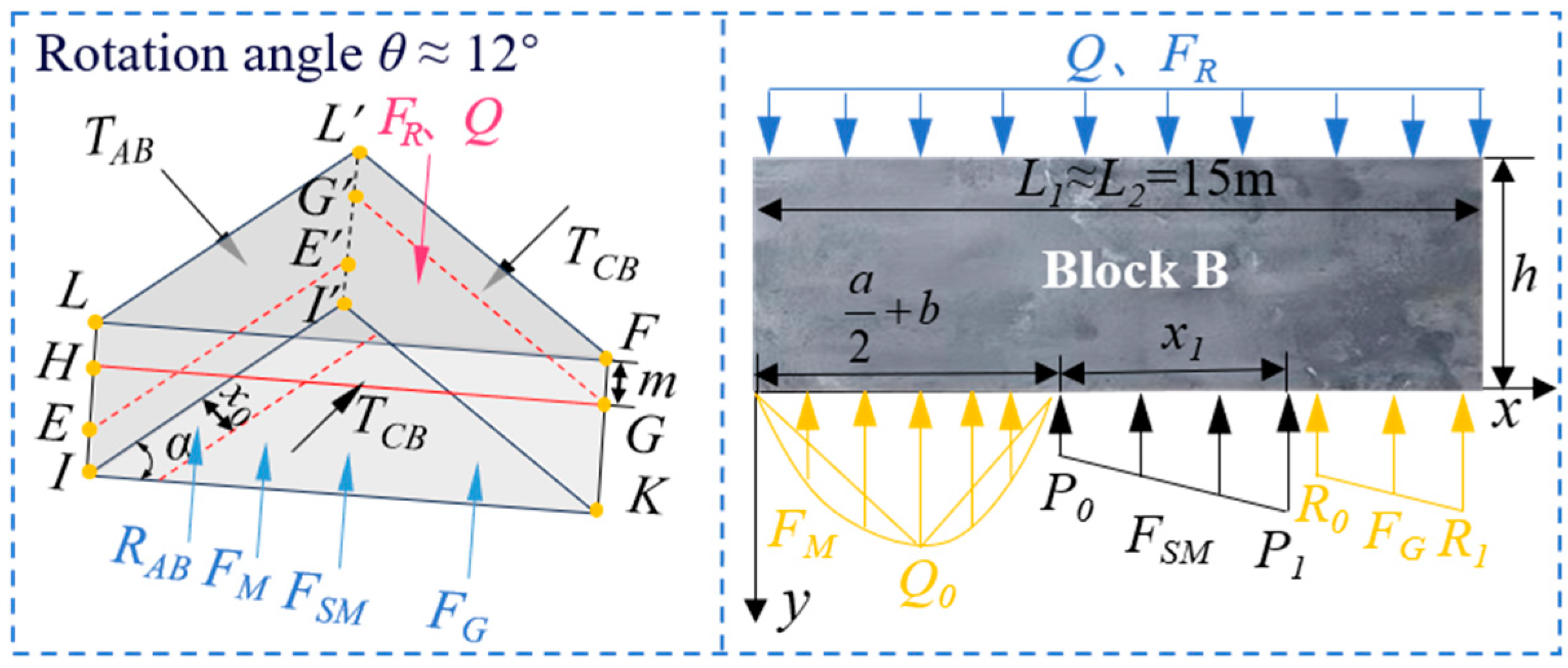
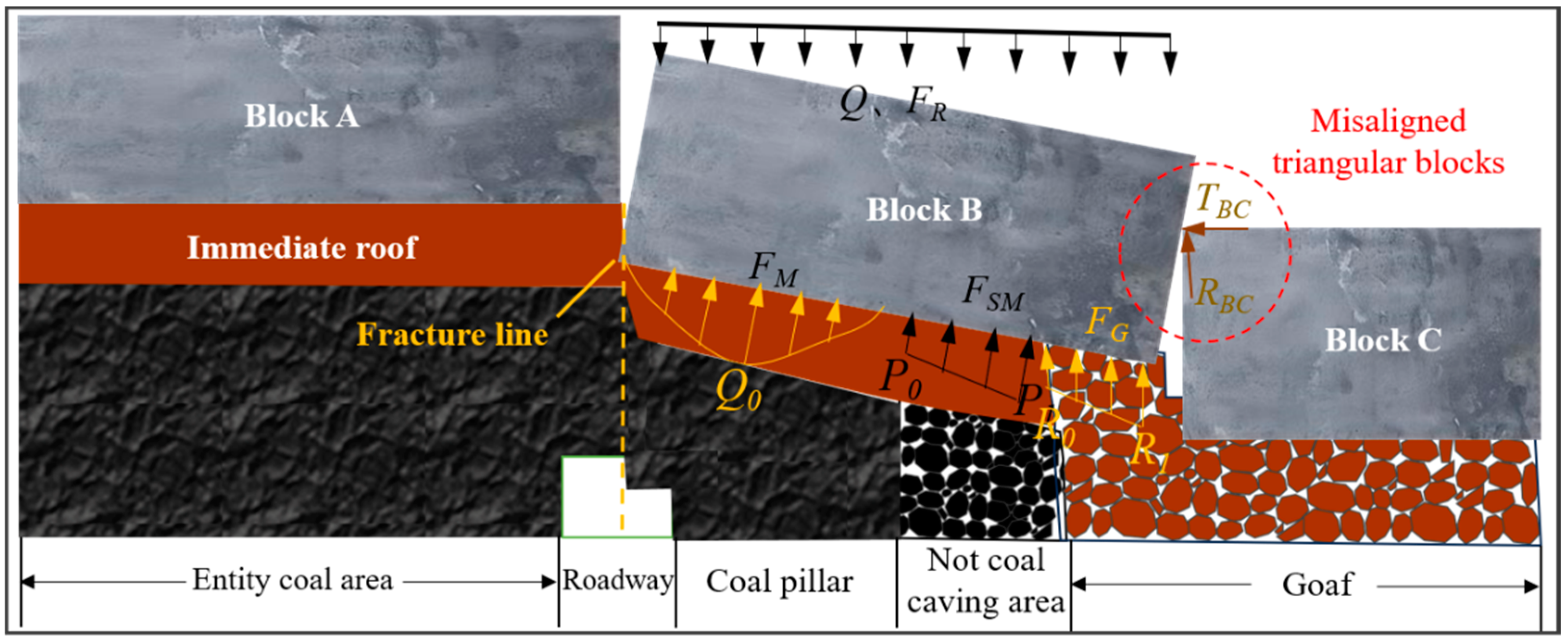
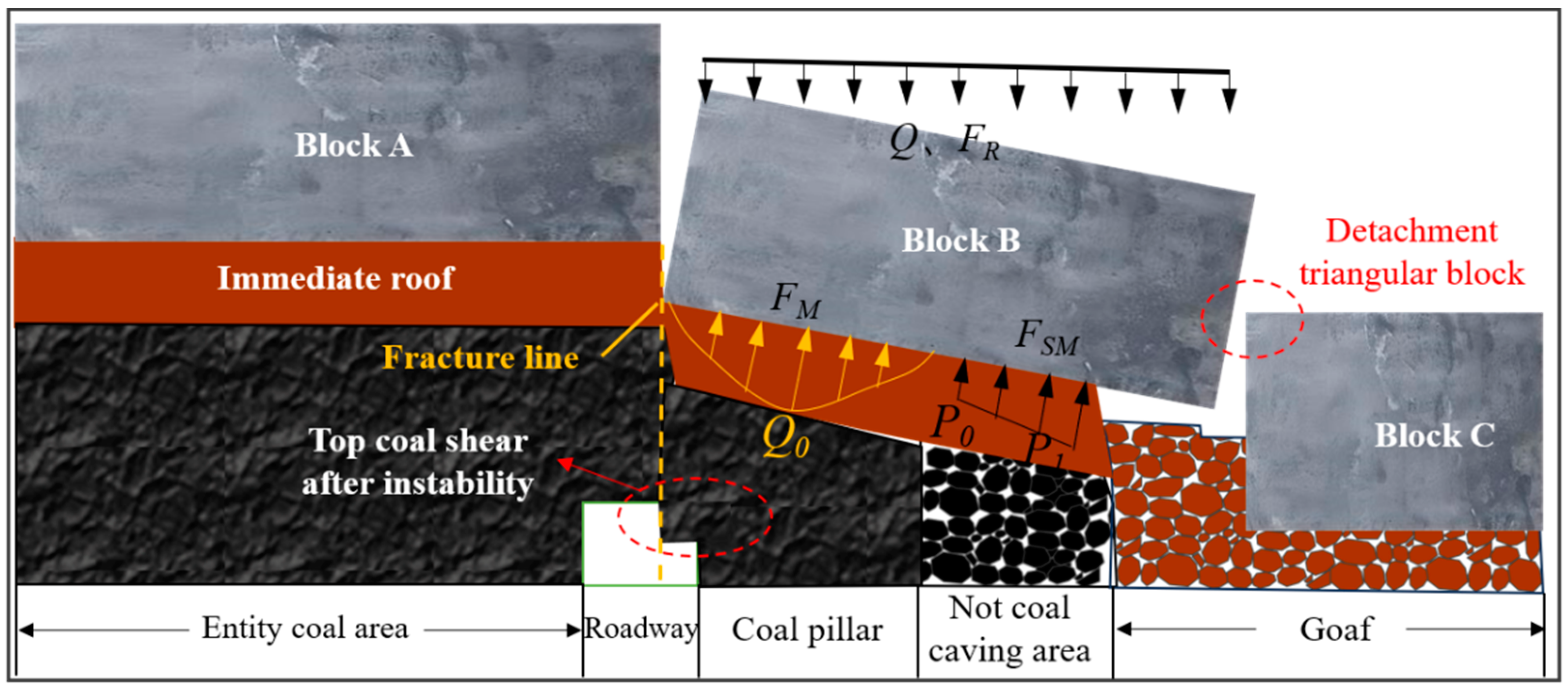

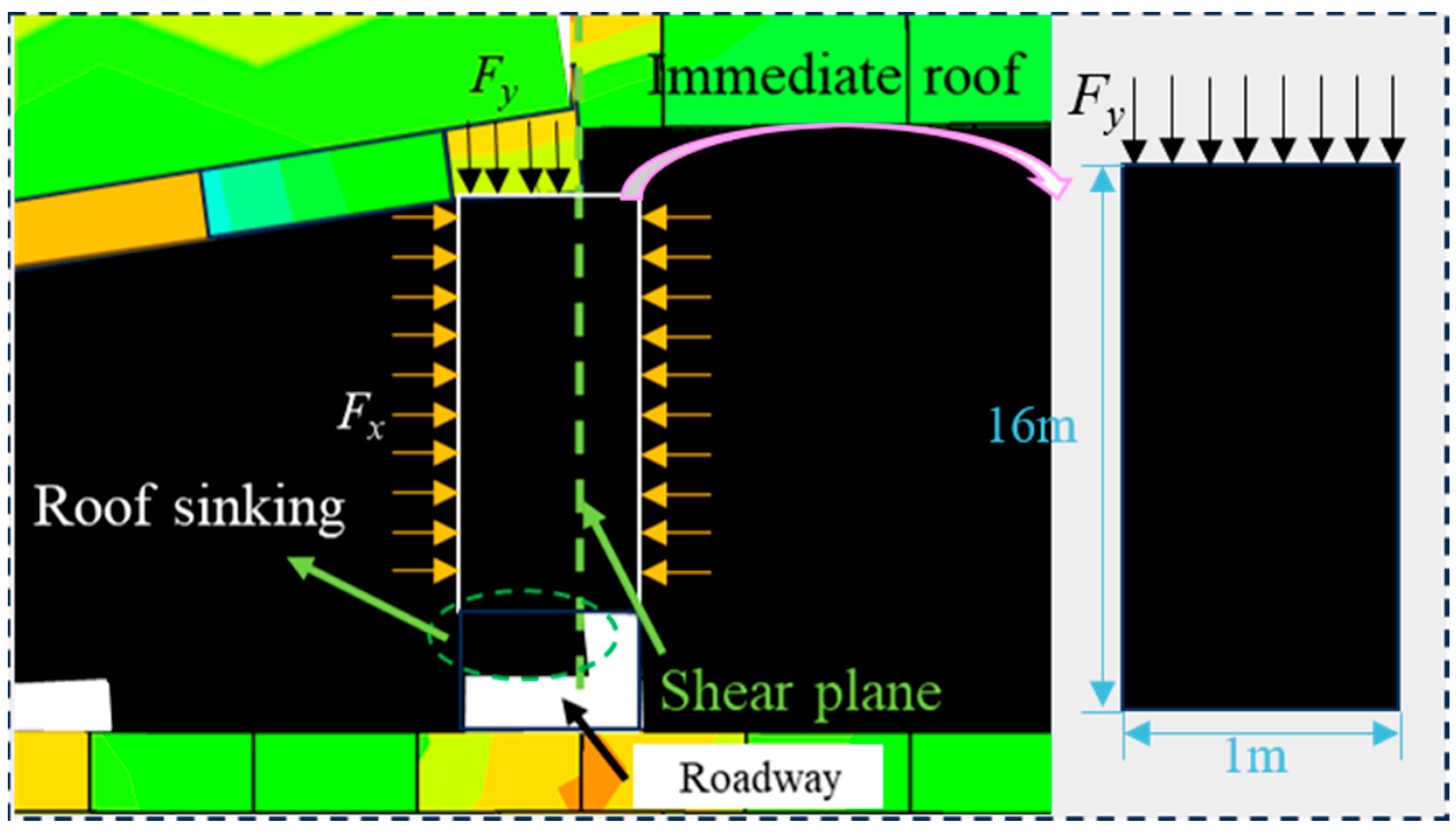


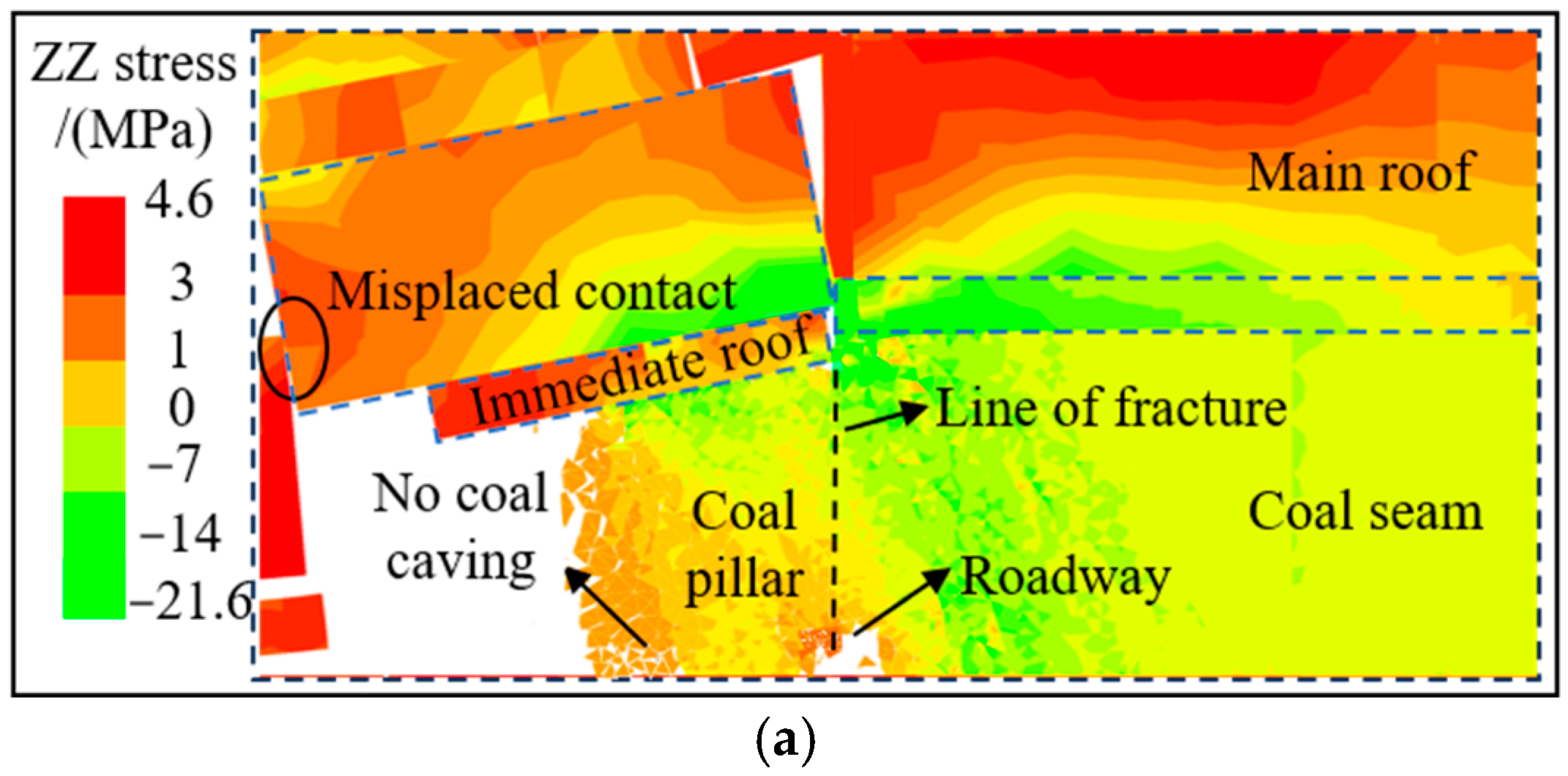
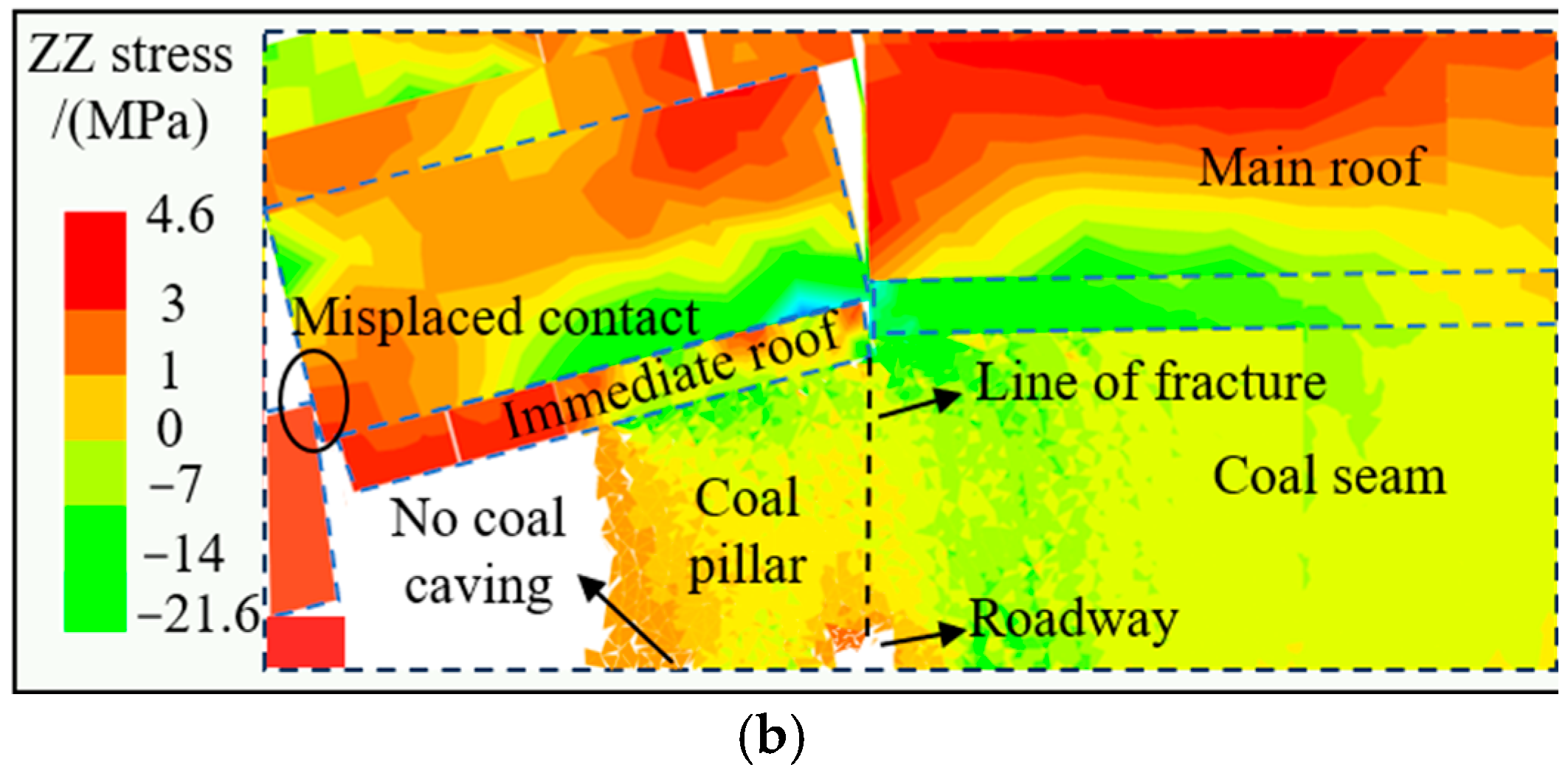
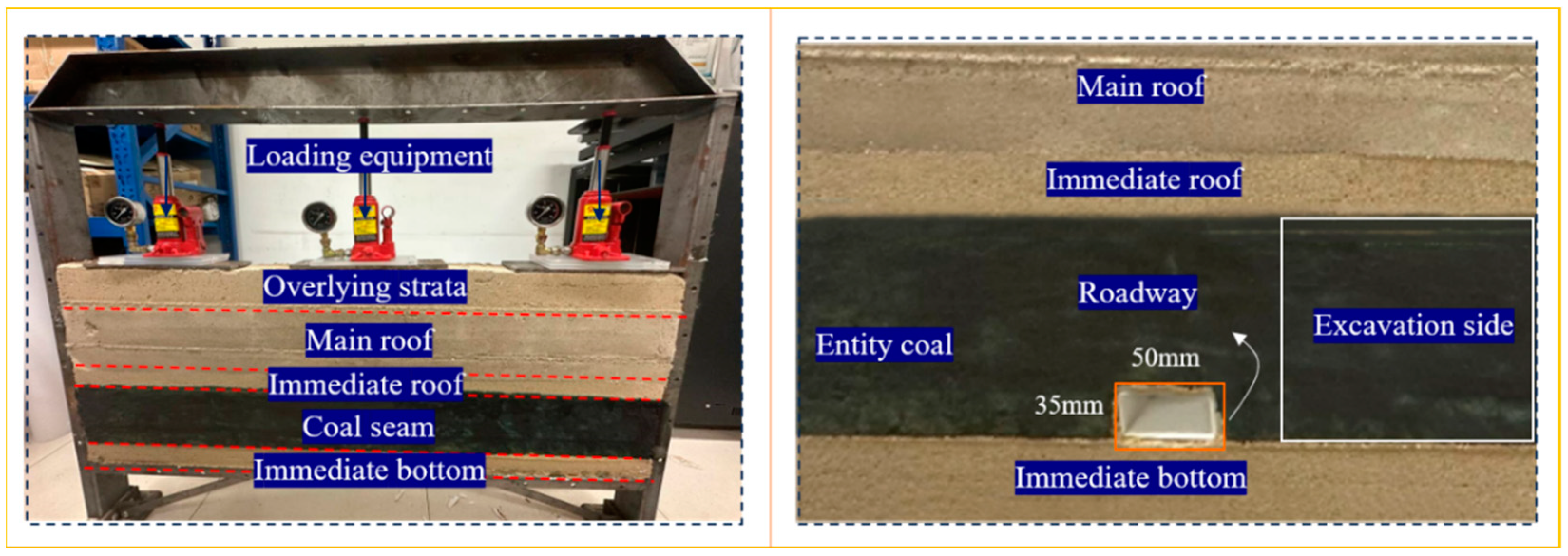


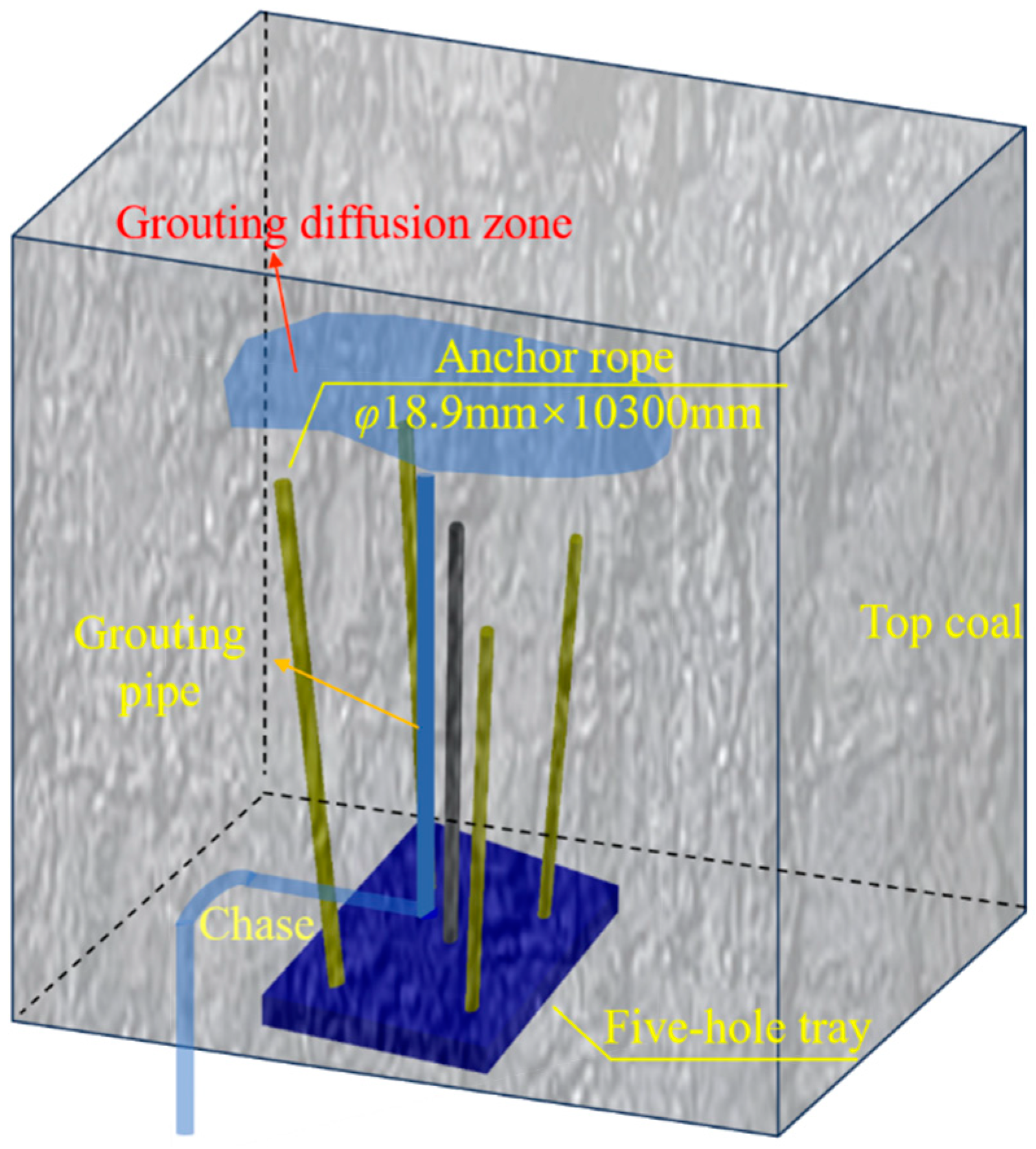

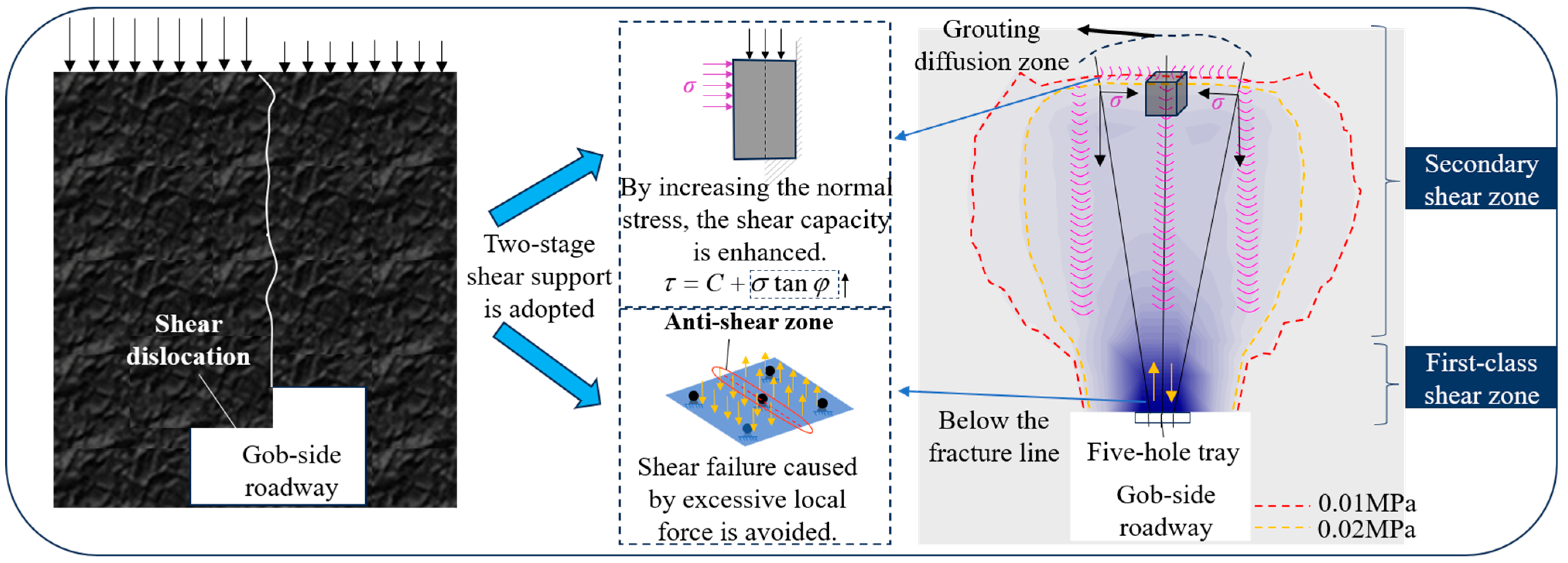
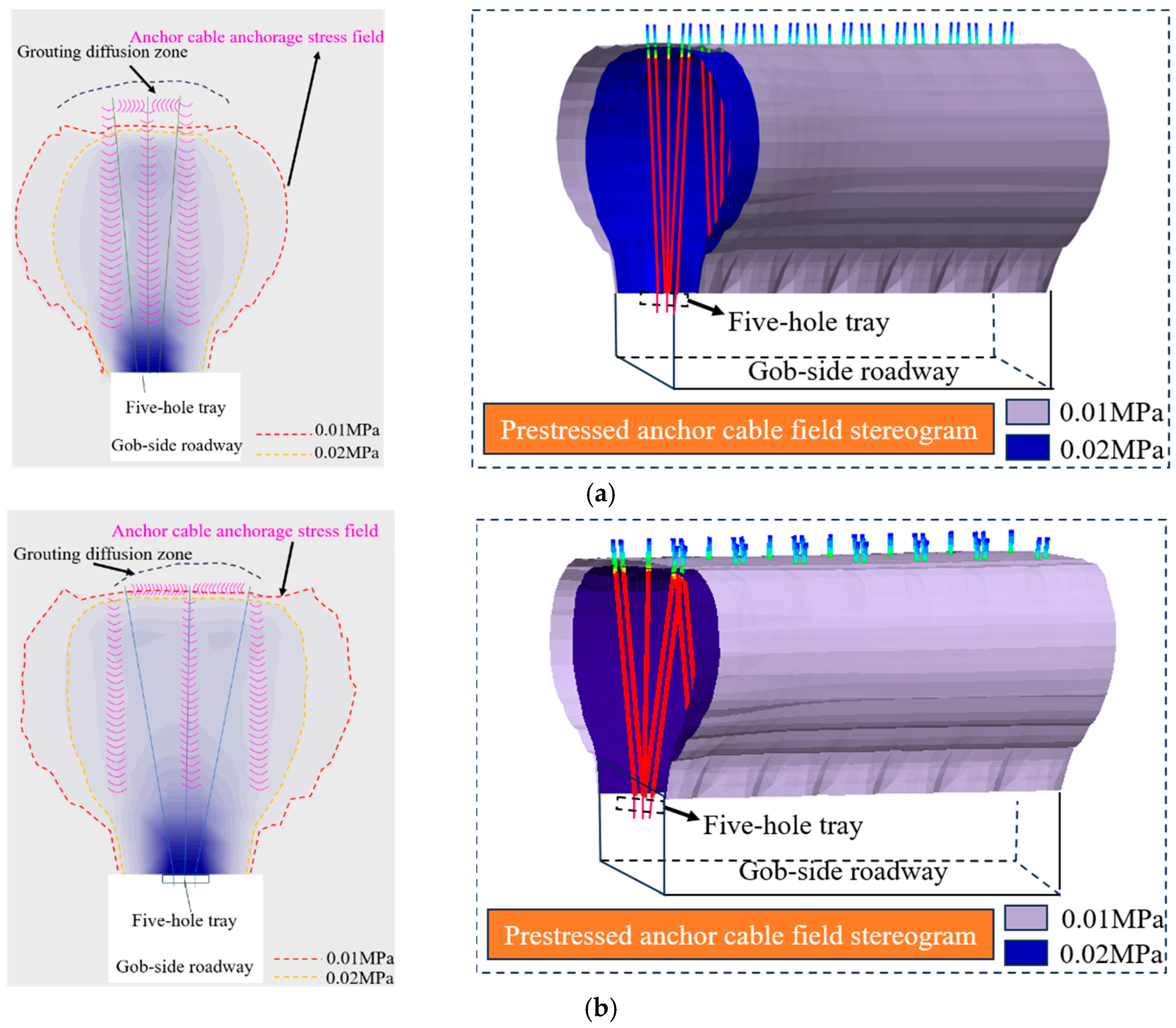


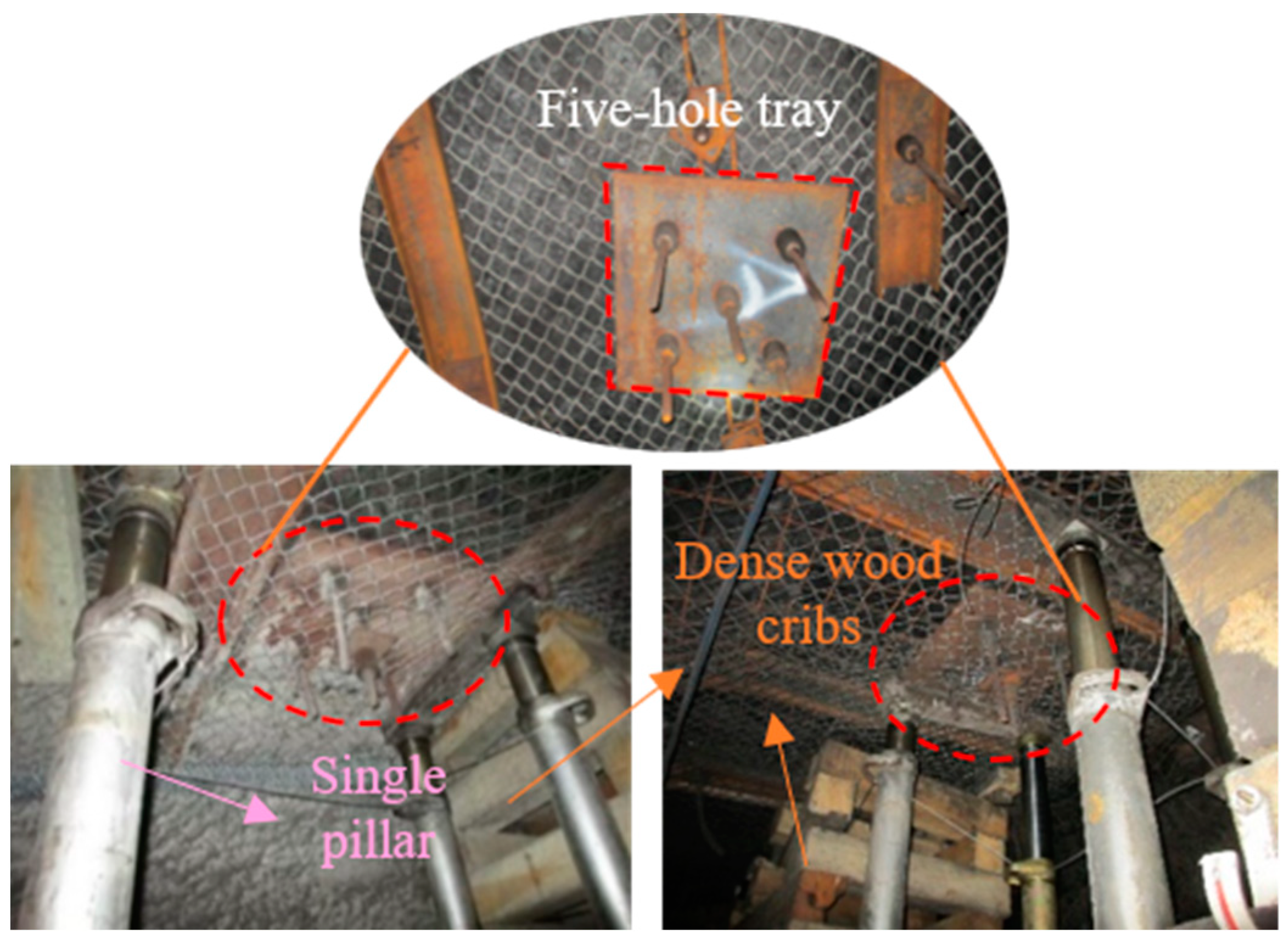
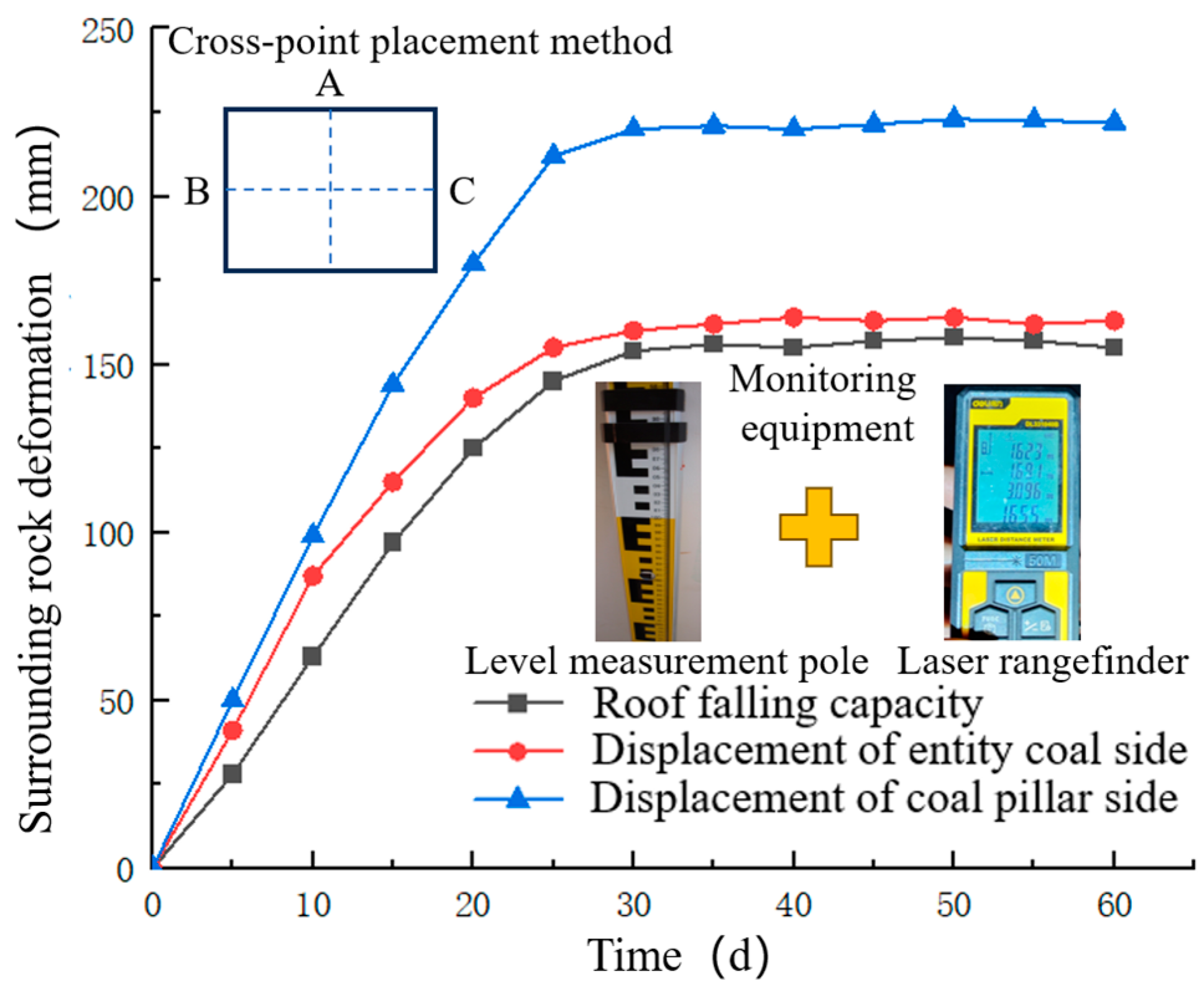
| Lithology | Density (kg/m3) | Bulk Modulus (GPa) | Shear Modulus (GPa) | Friction Angle (°) | Cohesion (MPa) | Tensile Strength (MPa) |
|---|---|---|---|---|---|---|
| Siltstone | 2650 | 10.2 | 7.8 | 39 | 3.3 | 2.4 |
| Carbon mudstone | 2298 | 6.4 | 5.5 | 25 | 1.9 | 1.6 |
| Coal | 1450 | 2.6 | 1.6 | 19 | 0.9 | 0.5 |
| Silty mudstone | 2446 | 6.0 | 5.3 | 29 | 2.2 | 1.8 |
| Fine sandstone | 2611 | 9.3 | 7.3 | 37 | 3.1 | 2.2 |
| Rock Formation | Actual Thickness /m | Layer Number | Quality Ratio of Sand, Lime, and Gypsum | Quantity/kg | |||
|---|---|---|---|---|---|---|---|
| Sand | Lime | Gypsum | Water | ||||
| Overlying strata | 10 | 3 | 6:0.5:0.5 | 13.1 | 1.1 | 1.1 | 1.2 |
| Main roof | 15 | 5 | 7:0.6:0.4 | 20.0 | 1.7 | 1.1 | 1.9 |
| Immediate roof | 4 | 2 | 6:0.5:0.5 | 6.5 | 0.5 | 0.5 | 0.6 |
| Coal seam | 19 | 5 | 8:0.7:0.3 | 20.4 | 1.8 | 0.8 | 1.9 |
| Immediate bottom | 5 | 2 | 6:0.5:0.5 | 6.5 | 0.5 | 0.5 | 0.6 |
Disclaimer/Publisher’s Note: The statements, opinions and data contained in all publications are solely those of the individual author(s) and contributor(s) and not of MDPI and/or the editor(s). MDPI and/or the editor(s) disclaim responsibility for any injury to people or property resulting from any ideas, methods, instructions or products referred to in the content. |
© 2025 by the authors. Licensee MDPI, Basel, Switzerland. This article is an open access article distributed under the terms and conditions of the Creative Commons Attribution (CC BY) license (https://creativecommons.org/licenses/by/4.0/).
Share and Cite
Chen, D.; Chang, J.; Zou, J.; Tian, C.; Xie, S.; Ni, J.; Guo, F.; Zhang, Z.; Zhao, W.; Yang, X.; et al. Mechanisms of Surrounding Rock Failure and Control Measures When Main Roof Fractures Directly Above Gob-Side Entry in Thick Coal Seam. Appl. Sci. 2025, 15, 4284. https://doi.org/10.3390/app15084284
Chen D, Chang J, Zou J, Tian C, Xie S, Ni J, Guo F, Zhang Z, Zhao W, Yang X, et al. Mechanisms of Surrounding Rock Failure and Control Measures When Main Roof Fractures Directly Above Gob-Side Entry in Thick Coal Seam. Applied Sciences. 2025; 15(8):4284. https://doi.org/10.3390/app15084284
Chicago/Turabian StyleChen, Dongdong, Jingchen Chang, Jun Zou, Chunyang Tian, Shengrong Xie, Jie Ni, Fangfang Guo, Zhixuan Zhang, Wenkang Zhao, Xiangyu Yang, and et al. 2025. "Mechanisms of Surrounding Rock Failure and Control Measures When Main Roof Fractures Directly Above Gob-Side Entry in Thick Coal Seam" Applied Sciences 15, no. 8: 4284. https://doi.org/10.3390/app15084284
APA StyleChen, D., Chang, J., Zou, J., Tian, C., Xie, S., Ni, J., Guo, F., Zhang, Z., Zhao, W., Yang, X., & Xing, S. (2025). Mechanisms of Surrounding Rock Failure and Control Measures When Main Roof Fractures Directly Above Gob-Side Entry in Thick Coal Seam. Applied Sciences, 15(8), 4284. https://doi.org/10.3390/app15084284






